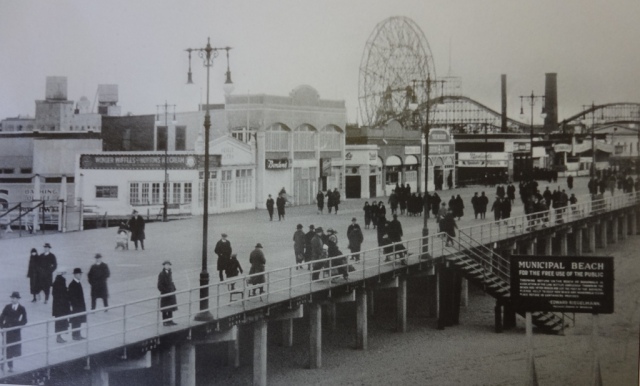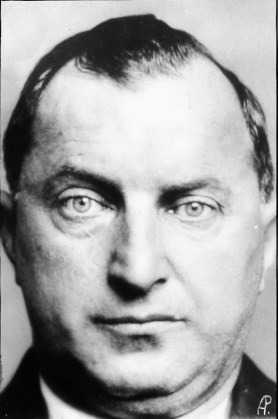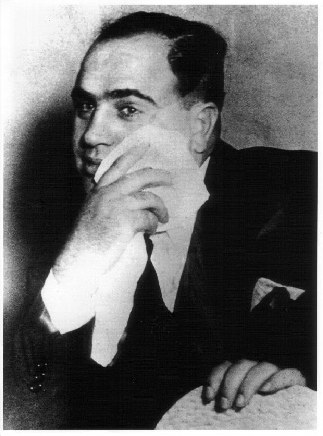When reporters worked up the nerve to ask, he’d say he got it from “a German machine gunner” in the trenches, or maybe while he was part of the Lost Battalion—but we already know he never served in World War I.1
So how exactly did Al get those famous scars?

A young Al Capone, already sporting his famous scars. Photo Source: American Haunting

A shot of Coney Island’s boardwalk, circa 1920. The Harvard Inn would have been somewhere off the boardwalk area. Photo Source: Flickr
One night after Al had been working there about a year some new customers walked into the joint: Frank Galluccio, a local tough, his kid sister, Lena Galluccio, and Frank’s date, Maria Tanzio. Al watched as they took a seat in the back and ordered some food and drink—or a lot of drinks, in Frank’s case. Frank proceeded to get completely hammered over the course of the night, but all Al noticed was Lena. According to Laurence Bergreen, author of Capone: The Man and the Era, Frank’s kid sister was a dark-haired Italian girl with “a gorgeous figure” that teenage Al couldn’t stop eyeing.7 Soon he just couldn’t take it anymore. He simply had to talk to her. Putting on his most charming smile, he intercepted her as she made her way across the dance floor and said, “in a very smooth and polite tone of voice, ‘And how are you this evening?’”8
But Lena wouldn’t even give him the time of day. She swept past him “without responding to his advance nor making the slightest bit of eye contact,” totally cold.9 Now Al felt like a fool.
But Al wasn’t the kind of guy to give up that easily. Throughout the night he kept finding excuses to come over to the trio’s table and chat with the girl—but his overtures fell on deaf ears. Lena just wasn’t interested. As Frank Galluccio said in an interview about the incident, “Lena ignored him every time, and every time he would pass our table he would try to talk to her. It seemed to me she didn’t want to be bothered with him.”10 Pretty soon “she was getting mad” and feeling like “he had a lot of nerve” to keep talking to her in spite of everything.11 After a while she suggested to her brother that “maybe you [could] ask him to please stop—but in a nice way.”12
Frank was about to do just that when Al leaned in close to Lena and said, loud enough so the people sitting at the next table could hear: “You got a nice ass, honey, and I mean that as a complement. Believe me.”13
That was the final straw. Frank lurched to his feet, drunk and mad as hell. As Robert J. Schoenberg writes in Mr. Capone, “the insult was bad enough; the fact that strangers had heard it made it insupportable.”14 Family was everything to a traditional Italian-American like Frank, and insulting a man’s family right in front of him was a horrible insult to his honor—not to mention Lena’s. “I won’t take that shit from nobody!” Galluccio roared. “Apologize to my sister now, you hear?”15
Accounts differ as to exactly what happened next.
Some say that Frank went nuts and launched himself at Capone in a drunken fury.16 Others say that Galluccio tried to make nice first, luring an oblivious Capone into range saying he “just wanted to talk”, then jumped “on his back like a cat” and went straight for his jugular with a pocketknife–or maybe a bottle opener, as “many old-timers in the Garfield neighborhood” of Brooklyn swear.17,18 Still others say that Galluccio, emboldened by alcohol, threw the first punch, but that it “was not enough to stop Capone;” after that, Al’s “unpredictable rage erupted” and Galluccio was forced to defend himself.19

Frank Galluccio, the guy who carved up Al Capone. Charming fellow, isn’t he? 😉 Photo Source: My Al Capone Museum
That’s when things turned ugly. “Capone wasn’t smiling any more” after that, remembers Frank. “He…came towards me. I called for the owner. [But] [h]e just kept coming towards me.”23 Caught up in a boozy haze, Galluccio found Capone very intimidating: “…to me he looked big and stocky, and I’m only five feet six…148 pounds. This guy looked like he was 200 pounds”—and he wasn’t stopping.24 Suddenly Galluccio feared for his life. He thought to himself: “Hey, this guy could hurt me bad if I let him get me. I better strike first and quick.”25 So, he says, “I whipped out my pocketknife and went for the son of a bitch’s neck.”26
Whatever happened, the end result was the same: Frank slashed Capone three times across the face, leaving a trio of deep, ugly cuts. Capone clutched at himself, bleeding like a stuck pig. There was “blood everywhere now, blood on the knife, blood all over Capone, blood on the floor.”27 The sight was enough to jar Galluccio back to his senses. He grabbed his sister and his date and bolted out the door. No one stopped him.
Back on the barroom floor, Al was bleeding all over the place. A fellow waiter gave him some bar towels to staunch the flow—and then some of Yale’s people rushed him off to Coney Island Hospital just in time.28 Once there, Capone ended up with 30 stitches and a nickname he’d carry for the rest of his life: Scarface.

Part of a mug shot from one of Al’s prison stays. I took the liberty of highlighting Al’s scars in yellow. Photo Source: FBI site
Alterio took Galluccio to see Giuseppe “Joe the Boss” Masseria and Charles “Lucky” Luciano to discuss the problem. After listening to his story, both crime bosses “agreed [that] nobody should insult another man in front of his own family and get away with it.”33 Luciano proposed a sit-down between himself, Joe, Yale, Galluccio and Capone at the Harvard Inn to sort things out. Once everyone showed up, the elder gangsters decreed that no more blood would be spilled on either side. There are many different stories about what exactly went down at this meeting, but as Galluccio remembers it, “Capone was ordered…not to look for revenge, and I was ordered to apologize.”34 Galluccio did so readily, especially once he got a good look at Al’s new scars: “…the look of the cuts on his face kind of shook me up, because I was really sorry for what I had done to him.”35 Later on Al apologized to Galluccio directly, admitting that he “was wrong when he insulted [Lena] in public.”36
The meeting seemed to mollify Capone. He never sought revenge for his scars later in his life, not even once he’d risen to power in Chicago. Whenever he saw Galluccio in person, “he would smile like he was trying to be nice” and leave him be.37 He even went out of his way to hire Galluccio as an extra bodyguard whenever he visited New York, paying him $100 a week—an exorbitant salary at the time—for his service.38 Of course, these gestures have something to do with Al being told during the Harvard Inn meeting in no uncertain terms that “should he attempt to take revenge, it would be his funeral.”39 Personally, I prefer biographer Luciano Iorizzo’s explanation. He claims that Al refusing to take revenge on Galluccio later on in his career “suggests that his respect for family values, on which he prided himself, went beyond his personal relatives” and that he realized he was in the wrong regarding Lena, rather than simply trying to save his own skin.40

Al looking kinda irritated–probably because the photographer caught his bad side. He really hated having this scars photographed, even though they helped solidify his reputation as a “tough guy.” Photo Source: Glogster

Al hides his scars from the camera. He would apply baby powder in order to make them less conspicuous, but it rarely helped. Photo Source: My Al Capone Museum
Works Cited:
1. There are two different sources for this quote. The “German machine gunner” comment comes from Richard Enright’s Capone’s Chicago (1987), while the Lost Battalion angle comes from Robert Schoenberg’s 1992 biography Mr. Capone.
Enright, Richard T., and Ray R. Cowdery. 1987. Capone’s Chicago. Lakeville, MN: Northstar Maschek Books. p 7.
Schoenberg, Robert J. 1992. Mr. Capone. New York, NY: Morrow. p 33.
2. Iorizzo, Luciano J. 2003. Al Capone a biography. Westport, CN: Greenwood Press. p 27.
3. Bergreen, Laurence. 1994. Capone: the man and the era. New York, NY: Simon & Schuster. p 49.
4. Ibid.
5. Enright, Richard T. Capone’s Chicago. p 7.
6. Iorizzo, Luciano J. Al Capone a biography. p 27.
7. Bergreen, Laurence. Capone: the man and the era. p 49.
8. Balsamo, William, and John Balsamo. 2011. Young Al Capone: the untold story of Scarface in New York, 1899-1925. New York, NY: Skyhorse Pub. p 112.
9. Ibid.
10. Balsamo, William. “Dillinger’s Brain!!!” Chicago Magazine, March 1990. p 113. (Content reprinted from a 1965 interview by William Balsamo)
11. Ibid.
12. Ibid. (All the other sources I consulted agreed on this point as well)
13. Balsamo, William. “Dillinger’s Brain!!!” p 114. (Again, all the sources agreed on this—but in this case, there were slight variations. Sources differ regarding who acted first (Al or Galluccio), exactly what was said, and how both of them reacted emotionally. Many sources took a lot of liberties ascribing motives, particularly Capone, and spun the story one way or another. Personally, I’m siding with the interview. However, many of the sources I referred to ALSO cited a Balsamo interview—a longer version of the one I’m quoting here—which I could not track down for the life of me.)
14. Schoenberg, Robert. Mr. Capone. p 33.
15. Balsamo, William. “Dillinger’s Brain!!!” p 114.
16. It’s interesting: if you type stuff like this into Google, many people seem to think this whole event was just a fit of drunken fury on Galluccio’s part. In actuality, while he was definitely mad about things, he was also very afraid of Capone.
17. Balsamo, William. Young Al Capone. p 118.
18. Iorizzo, Luciano J. Al Capone a biography. p 27.
19. Bergreen, Laurence. Capone: the man and the era. p 49.
20. Schoenberg, Robert. Mr. Capone. p 33.
21. Balsamo, William. “Dillinger’s Brain!!!” p 114.
22. Schoenberg, Robert. Mr. Capone. p 33.
23. Ibid.
24. Balsamo, William. “Dillinger’s Brain!!!” p 114.
25. Ibid.
26. Ibid.
27. Bergreen, Laurence. Capone: the man and the era. p 49.
28. Balsamo, William. Young Al Capone. p 118.
29. There are actually two sources cited here. The “cut up bruiser” comes from Schoenberg, the “Yale crew” bit is from p 114 of the Balsamo interview.
30. Schoenberg, Robert. Mr. Capone. p 33.
31. Balsamo, William. Young Al Capone. p 118.
32. Balsamo, William. “Dillinger’s Brain!!!” p 114.
33. Ibid.
34. Ibid.
35. Ibid.
36. Ibid.
37. Ibid.
38. Schoenberg, Robert. Mr. Capone. p 34.
39. Bergreen, Laurence. Capone: the man and the era. p 30.
40. Iorizzo, Luciano J. Al Capone a biography. p 27.
41. Balsamo, William. “Dillinger’s Brain!!!” p 114.
42. Ibid.
43. Ibid.

Really enjoy the article. I knew the story, but only in its essential points.
I too think Capone never seeked revenge because he understood he was in the wrong with Lena. He was fierce and violent, but he did value family.
LikeLike
Thanks! Glad you liked it :). I agree—I think a lot of people give him a bum rap in that regard. A number of the biographies I’ve read seem to think that they have to show that they don’t condone the stuff he did by writing him up as if he’s an evil, unthinking, unfeeling thug, but personally I find that a really unfair treatment of a complicated man…
LikeLike
The Boardwalk didn’t exist in 1917. It opened in 1923. The Harvard Inn would have been located on the Bowery between modern day W.15th st and Schweikerts Walk. If you stand behind Nathan’s Famous and walk 50 feet to the west you will be standing where the Harvard Inn was located. The Harvard Inn burned down in January of 1925. Everything Al Capone brought with him to Chicago he learned on Coney Island’s famed Bowery.
LikeLike
1923 huh? Interesting. I’m sorry to say I didn’t double-check when the Boardwalk was created. Every source I read for this story claimed that The Harvard Inn was on or near the Boardwalk, so I assumed it was there at the time of Al’s knifing. Thanks for the correction. Are you with a Coney Island tour company? Perhaps I could cite your website. I’d agree with you about Capone—it was quite the education!
LikeLike
I am the founder of Coney Island Tours. This story is part of my tour. I’m the editor of TheConeyIslandBlog.com. You can cite Michael Quinn of Coney Island Tours. Thanks.
LikeLike
Pingback: The Many Nicknames of Al Capone | A Smile And A Gun
SO interesting! I never knew any of this! I really enjoyed your first-rate article.
LikeLiked by 1 person
uff, nei og nei, sÃ¥ dumt.. Ønsker deg GOD BEDRING! Kos deg med film og masgnia;) Har lest bloggen din i ca 1 Ã¥r og liker den veldig godt! Mange hilsner fra Hilde i Norge 🙂
LikeLike
Pingback: The History Behind Riley and the Roaring Twenties – James Anderson O'Neal Books
I wouldn’t put much value on the quote from Balsamo, even though it’s a quote that grabs readers’ attention. I didn’t find much of anything he wrote about Brooklyn’s White Hand to be true, and nobody knows as much about that gang as I do. Still though, this article is a fun read. Check out the historical novel DIVIDE THE DAWN (Fall, 2019), which takes place in Brooklyn, 1919.
https://artofneed.wordpress.com/2019/03/25/novel-divide-the-dawn/
LikeLike
Thanks! Ultimately I used his quote because it seemed to be the original source for the story at the time, because when I dug through bibliographies in Capone bios within the past 30 years or so, this article kept coming up, so I wanted to include it. Have you read Basalmo’s co-authored book, Young Al Capone? He tells a lot of stories there too with virtually no sources, and claims that even now he c
LikeLiked by 1 person
…can’t reveal them due to safety concerns. Anyway, thanks for the book link, I’ll definitely check it out! I don’t know much about the White Hand beyond Bill Lovett’s grisly end.
LikeLike
Very interested in this. I want to know what happened to Lena, Frank Galluccio’s sister. A friend of mine’s mother was a Lena. She was a sister of someone in the Genovese family.
LikeLike